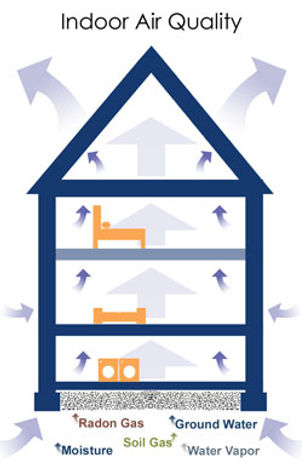

Call Our Office Today!
Tel: (615) 360-7000 Ext. 7872
Stack Effect
Stack effect is the movement of air into and out of buildings, chimneys and flues and is driven by a difference in indoor to outdoor air density resulting from temperature and moisture differences.

Pollutants can enter from lower levels through Stack-Effect.
Since the 1970s, homes have been built increasingly airtight to save on gas and electricity reducing the amount of air exchange. Air tight (Energy Efficient) homes have drawn more attention to all of the pollutants a basement or crawl space has to offer through what we call “stack effect”.
Moisture, dampness, and leaks can create an unhealthy environment and through a natural occurrence of stack -effect, air is constantly rising from the basement into the upper levels of the home. This "bad air" can introduce a wide range of toxins and soil gases into the home's living space.
Air is constantly rising from the basement / crawl space
into the upper levels of the home.

Stack effect is the movement of air into and out of buildings, chimneys and flues and is driven by a difference in indoor to outdoor air density resulting from temperature and moisture differences. Less dense hot air rises and is replaced by denser, cool air.
The greater the thermal difference and the height of the structure, the greater the stack effect. The stack effect is also referred to as the "chimney effect" and it helps drive natural ventilation in a house. So if the air is unhealthy in your basement and or crawlspace, that same year is most likely permeating the upper levels of your home or workplace.